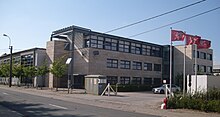Confectionery company founded in Belgium
Lotus Bakeries NV is a Belgian multinational snack food company founded in 1932. Based in Lembeke, Kaprijke, the company's best known[citation needed] product is Speculoos (known as Biscoff in the United States, the United Kingdom, Japan and Australia). Other Lotus brands include nākd, TREK, BEAR, Kiddylicious, Peter’s Yard, Dinosaurus, Peijnenburg and Annas.
Lotus Bakeries have production facilities in Belgium, the Netherlands, France, Sweden, South Africa and the United States. A third production facility for Biscoff is currently under construction in Thailand and will be operational by 2026.
Lotus Bakeries are active in about 70 countries in Europe, America, Asia and Australia. The company has around 3,000 employees and achieved a revenue of EUR 1,063.0 million in 2023.
Since 1988 the shares of Lotus Bakeries are listed on Euronext Brussels. Most are owned by the Boone and Stevens families. Jan Boone [nl], grandson of founder Jan Boone Sr., has been the CEO since 2011.[1]
History
The company was founded in Lembeke in 1932 by the brothers Jan, Emiel and Henri Boone. Jan named it Lotus, after the flower that symbolises purity.
In the 1950s, the brothers began to package the Lotus Speculoos biscuits individually, and from 1956 they were offered in Belgian catering establishments alongside coffee. Soon after, in 1960, Lotus Speculoos was distributed in neighbouring countries.
Partnering with the Stevens family in 1974, Lotus merged with Corona and now also includes cakes and pastry within its product range. Prepackaged pastries experienced rapid growth at that time.
The Speculoos biscuit is branded Lotus Biscoff, a brand name launched since 1986 and gradually introduced in all countries. In the mid-1980s, several airlines began serving Lotus Biscoff as an in-flight treat.[2]
From the 1990s, Lotus Bakeries grew steadily with a series of integrations:
- 1999: Integration of Suzy wafels
- 2006: Integration of gingerbread (Peijnenburg)
- 2008: Integration of ginger cookies (Annas)
- 2012: Acquisition of Dinosaurus-brand and start of own production from mid-2013 onwards
Since 2015, the company also became active in the natural snacking category with the acquisition of three British companies.[3]
- 2015: strategic partnership with Natural Balance Foods ('NBF') in the healthy snacking segment. NBF is a British wholefood company which offers bars under the nākd and TREK brands.
- 2016: acquisition of BEAR, a kids' fruit snacking brand that offers natural snacks made from fruit.
- 2018: acquisition of Kiddylicious, a British baby snacking brand that creates snacks for growing babies, toddlers and preschoolers.
- 2020: acquisition of the majority of the remaining shares in British company Natural Balance Foods from the founders. As a result, Lotus Bakeries has full control of the entire Natural Foods portfolio.[4]
- 2020: creation of a new International HQ for Lotus™ Natural Foods in Switzerland.
- 2022: acquisition of 100% of the shares of Peter's Yard, a British artisanal sourdough company that produces sourdough crackers, crispbreads and crisps.
Over the past years, Lotus Bakeries has invested in several production facilities on different continents:
- Historically Biscoff was produced (and continues to be produced) in Lembeke, Belgium. In 2019, a new manufacturing facility was opened in Mebane, North Carolina in the United States, marking the first production of Biscoff outside of Belgium. Currently, a third production facility for Biscoff is being built in Thailand and will be operational in 2026.
- Since 2019 a production facility for the Group’s Natural Foods’ Brand BEAR has been located in South Africa, Wolseley. And early 2024, the nākd production facility, adjacent to the BEAR production site, was inaugurated.
- Lotus Bakeries’ Local Heroes products are produced within their home-markets Belgium, the Netherlands, France and Sweden.
Organisation
Karel Boone, the son of founder Jan Boone Sr., became a director in 1966 and was the CEO of Lotus Bakeries for 32 years from 1974-2006. He was also from 1966-2012 the president of the company for 46 years.
In 2006, his brother Matthieu took over as CEO.[5] At the end of 2011, a new generation took over with Jan Boone becoming the CEO.[6]
Executive Committee
The Executive Committee determines the strategy and objectives of the Lotus Bakeries Group and submits them to the Board of Directors for approval.[7]
- Jan Boone, CEO
- Isabelle Maes, CMO Lotus Bakeries & CEO Natural Foods
- Mike Cuvelier, CFO
- Ignace Heyman, COO
- William Du Pré, Corporate Director Quality, Procurement and R&D
